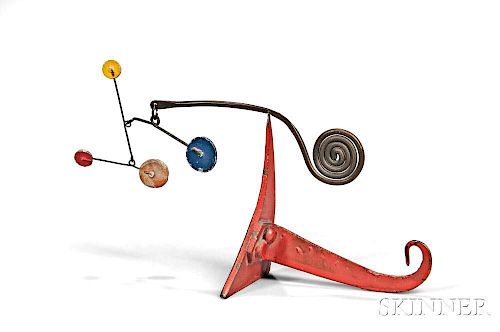Alexander Calder (American, 1898-1976) Untitled (Standing Mobile)
Lot 525
About Seller
Bonhams Skinner
274 Cedar Hill Street
Marlborough, MA 01752
United States
Founded over four decades ago, Bonhams Skinner offers more than 60 auctions annually. Bonhams Skinner auctions reach an international audience and showcase the unique, rare, and beautiful in dozens of categories, including the fine and decorative arts, jewelry, modern design, musical instruments, sc...Read more
Categories
Estimate:
$100,000 - $150,000
Absentee vs Live bid
Two ways to bid:
- Leave a max absentee bid and the platform will bid on your behalf up to your maximum bid during the live auction.
- Bid live during the auction and your bids will be submitted real-time to the auctioneer.
Bid Increments
| Price | Bid Increment |
|---|---|
| $0 | $10 |
| $100 | $25 |
| $500 | $50 |
| $1,000 | $100 |
| $3,000 | $250 |
| $5,000 | $500 |
| $10,000 | $1,000 |
| $30,000 | $2,500 |
| $50,000 | $5,000 |
| $100,000 | $10,000 |
| $300,000 | $25,000 |
| $500,000 | $50,000 |
| $1,000,000 | $100,000 |
About Auction
By Bonhams Skinner
May 19, 2017 - May 20, 2017
Set Reminder
2017-05-19 16:00:00
2017-05-20 16:00:00
America/New_York
Bidsquare
Bidsquare : Fine Paintings & Sculpture
https://www.bidsquare.com/auctions/skinner/fine-paintings-sculpture-2343
Bonhams Skinner bidsquare@bonhamsskinner.com
Bonhams Skinner bidsquare@bonhamsskinner.com
- Lot Description
Alexander Calder (American, 1898-1976)
Untitled (Standing Mobile), c. 1953
Unsigned.
Sheet metal, brass wire, and paint, height 3 in. (7.5 cm) to topmost disk.
Condition: Paint losses, slight bend to upper point of the sheet metal base, tarnish to brass wire.
Provenance: Commissioned from the artist by Betty Milton, by family descent to the current owner.
N.B. This work is registered in the archives of the Calder Foundation, New York, under application number A28299.
By the 1950s, Alexander Calder had become an internationally recognized and respected artist. He was chosen to represent the United States in the 1952 Venice Biennale at which he won the grand prize for sculpture. That same year, he designed sets and costumes for the play Nuclea which opened in Paris, and he worked on the design for a fountain for architect Eero Saarinen's General Motors Techinical Center project in Michigan. Throughout this period, Calder maintained a very high rate of production, working on large-scale sculpture commissions as well as small works like this untitled standing mobile.
Though born into a family of artists, Calder initially rejected an artistic career, choosing instead to study mechanical engineering. Ultimately, he conceded to his artistic roots and enrolled in the Art Students League in New York in 1923 and soon afterwards began making regular visits to Paris where he worked on and exhibited small, figurative wire sculptures. In Paris, Calder met fellow artists Joan Miró, Fernand Léger, and Piet Mondrian, all of whom influenced Calder's progression to abstract forms in his works. Calder created his first kinetic sculptures in 1931, and Marcel Duchamp began referring to the works as "mobiles." At first, Calder's mobiles were motorized, but he quickly realized that he could propel his works through ambient air currents.
Calder worked persistently throughout his career on variations of his abstract mobiles (suspended moving sculptures), standing mobiles (anchored moving sculptures), and stabiles (stationary constructions). The scale of his sculptures varies widely, from colossal outdoor stabiles to diminutive standing mobiles. Though he often made small maquettes as part of the design process for large sculptures, he meant the majority of his small sculptures to be artworks in their own rights. For this untitled standing mobile, Calder employed his hallmark form-colorful, abstract shapes suspended on carefully balanced systems of wire hangers. Calder's interests in physics, astronomy, and kinetics, coupled with his involvement in the Abstraction-Création group of artists in Paris, informed the primary colors and geometric and organic shapes he used in his carefully engineered constructions. The sturdy base of this tiny standing mobile gives way to a thin, delicate wire that sits on the tip of the base via a tiny dimple on the underside of the wire. Calder weighted the circular shapes on either end of the wire to enable it to balance perfectly. Engineering skill, artistic genius, elegance, and playfulness all characterize Calder's ouvre. Describing his motives, Calder told an interviewer, "I want to make things that are fun to look at, that have no propaganda value whatsoever." (1)
1. "Calder" in Selden Rodman, Conversations with Artists (New York, 1957), pp. 136-42; Martha Prather, Alexander S.C. Rower, and Arnauld Pierre, Alexander Calder: 1898-1976, National Gallery of Art, Washington (New Haven and London: Yale UP, 1998) exh. cat.
Estimate $100,000-150,000
Dimensions of the red sheet metal support are 2 1/2 x 1 1/2 x 3 in.
The assembled standing mobile measures 5 3/8 inches across.
The absence of a condition statement does not imply that the lot is in perfect condition or completely free from wear and tear, imperfections or the effects of aging. Condition requests can be obtained via email (lot inquiry button) or by telephone to the appropriate gallery location (Boston/617.350.5400 or Marlborough/508.970.3000). Any condition statement given, as a courtesy to a client, is only an opinion and should not be treated as a statement of fact. Skinner Inc. shall have no responsibility for any error or omission. - Shipping Info
-
Please visit http://www.skinnerinc.com/services/payment-and-shipping/ for information regarding the collection of items purchased at auction.
-
- Buyer's Premium



 EUR
EUR CAD
CAD AUD
AUD GBP
GBP MXN
MXN HKD
HKD CNY
CNY MYR
MYR SEK
SEK SGD
SGD CHF
CHF THB
THB


















